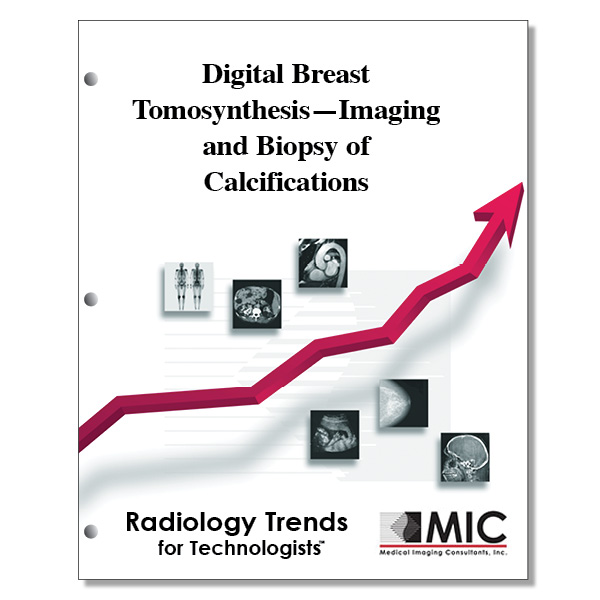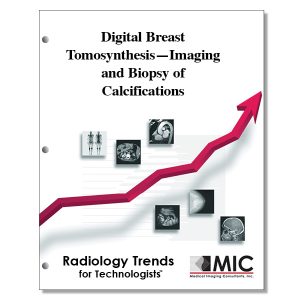

Digital Breast Tomosynthesis—Imaging and Biopsy of Calcifications
The digital breast tomosynthesis imaging appearance of breast calcifications is reviewed and biopsy techniques of calcifications are discussed.
Course ID: Q00598 Category: Radiology Trends for Technologists Modality: Mammography2.25 |
Satisfaction Guarantee |
$24.00
- Targeted CE
- Outline
- Objectives
Targeted CE per ARRT’s Discipline, Category, and Subcategory classification for enrollments starting after January 27, 2023:
[Note: Discipline-specific Targeted CE credits may be less than the total Category A credits approved for this course.]
Mammography: 2.25
Image Production: 0.75
Image Acquisition and Quality Assurance: 0.75
Procedures: 1.50
Anatomy, Physiology, and Pathology: 0.75
Mammographic Positioning, Special Needs, and Imaging Procedures: 0.75
Registered Radiologist Assistant: 0.75
Procedures: 0.75
Thoracic Section: 0.75
Outline
- Introduction
- DBT and Synthesized Mammography
- DBT for Screening
- Screening Protocols
- Diagnostic Performance of DBT in the Detection of Breast Cancer
- Calcifications and Breast Cancer
- Types of Breast Calcifications
- Benign Calcifications
- Probably Benign Calcifications
- Suspicious Calcifications
- Distribution
- Calcification Artifacts at DBT
- Clinical Performance of DBT in the Detection of Breast Calcifications
- DBT versus FFDM
- DBT Plus FFDM versus FFDM Alone
- SM versus FFDM
- Calcification Conspicuity
- DBT-guided Biopsy
- Future Directions for DBT
- Conclusion
Objectives
Upon completion of this course, students will:
- state the cancer mortality reduction percentage achieved with screening mammography
- list the patients best served by FFDM
- explain the advantages of DBT over FFDM
- describe how the x-ray tube moves in DBT
- compare radiation dose protocols between DBT and FFDM
- recall the factors that affect the range of breast radiation dose at DBT
- state what synthesized mammograms are created from
- compare the approximate reduction in radiation does that is observed with DBT plus synthesized mammography as compared to DBT plus FFDM
- describe how DBT for breast cancer screening improves sensitivity and specificity over the use of FFDM
- compare screening protocols for DBT plus FFDM versus DBT alone
- discuss the combined techniques for increasing sensitivity and specificity of breast cancer screening
- list the screening trials that compare the use of DBT combined with FFDM to the use of FFDM alone
- list how invasive and in situ breast cancers can manifest
- describe how calcification morphology is classified
- describe how benign calcifications are seen at mammography
- know the BI-RADS category for benign calcifications
- describe the appearance of skin calcifications
- recognize typically benign versus suspicious morphology related to breast calcifications
- describe the appearance of vascular calcifications
- describe rim calcifications
- recall how lesions with a less than 2 percent likelihood of malignancy are classified
- state the interval follow-up for calcifications detected at baseline screening mammography that have a probably benign appearance
- list the morphologic descriptions for suspicious calcifications
- list how calcification distribution can be described
- describe artifacts most frequently related to calcifications
- recall how shadow artifacts appear on synthesized mammograms
- choose the study that included 99 cases of malignant calcifications in order to compare their detection between DBT and FFDM
- state which trial had similar sensitivities when comparing digital breast imaging plus FFDM with FFDM alone in the detection of malignant calcifications
- give the performance percentage of DBT plus synthesized mammography in the detection of malignant calcifications as seen in the TOMMY trial
- list the factors that may cause lower spatial resolution at DBT
- compare the pros and cons of the use of DBT for diagnosing breast calcifications
- list the challenges of stereotactic biopsy
- discuss why conventional stereotactic breast biopsy is still needed
- describe patient position for DBT-guided breast biopsy
- choose which trial will compare DBT and FFDM screening protocols with the objective of determining which is the best screening modality
